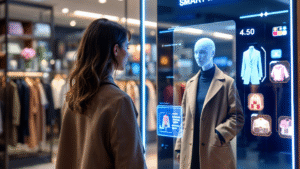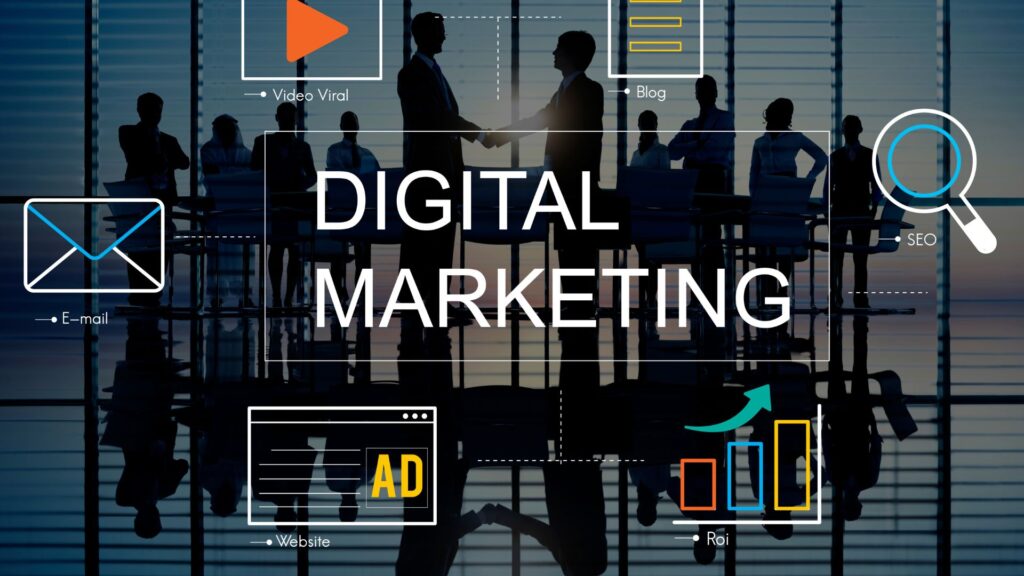Digital Marketing Trends 2025 are not just about algorithms and automation—it’s about human connection, intelligent technology, and ethical innovation. The landscape is changing at an unprecedented rate, shaped by evolving consumer expectations, stricter privacy regulations, and groundbreaking technologies like generative AI, 5G, and immersive media. To help marketers, entrepreneurs, and businesses of all sizes prepare for the road ahead, this in-depth guide breaks down the most important Digital Marketing Trends 2025 has to offer. From AI personalization to voice search, from zero-party data to immersive content strategies, we cover everything you need to future-proof your brand.
AI-Driven Personalization: The New Standard.

By 2025, personalization isn’t just a luxury—it’s an expectation. As one of the defining Digital Marketing Trends 2025, AI-driven personalization is revolutionizing how brands connect with their audiences. Consumers now demand tailored experiences across every touchpoint. Advanced personalization tools powered by artificial intelligence enable marketers to move beyond basic demographics and tap into predictive, real-time engagement that anticipates user needs and behaviors. To stay competitive, businesses must prioritize a strong first-party data strategy that captures meaningful customer insights. Integrating machine learning into your segmentation efforts will allow for hyper-targeted campaigns, ensuring every interaction feels relevant, timely, and personal.
What’s Changing ?
Among the most transformative Digital Marketing Trends 2025 is the shift toward hyper-responsive, personalized marketing. Today, dynamic content delivery systems adjust in real time based on user behavior, ensuring that every interaction is contextually relevant and engaging. Hyper-segmentation and intelligent audience clustering are replacing broad demographic targeting, allowing brands to reach highly specific consumer segments with precision. On top of that, AI-assisted content creation is empowering marketers to deliver personalized messages during micro-moments—those brief, high-intent windows when consumers are most receptive.
Tools and Platforms to Watch:
- Adobe Sensei
- Salesforce Einstein
- Segment by Twilio
- ChatGPT for content personalization
Key Stats:
- Epsilon reports that personalized marketing drives purchase decisions for 80% of consumers.
The Rise of Voice and Visual Search

Talking to devices like Alexa, Siri, and Google Assistant has become second nature for many consumers, shifting how they find information and products. Alongside voice search, visual search tools such as Google Lens and Pinterest Lens are further transforming how users interact with content, enabling them to search using images instead of just text. To stay competitive, marketers should explore tools like Answer the Public to uncover voice-based search queries, leverage Google Search Console to track voice query performance, and monitor Pinterest Trends to understand how visual search is shaping consumer behavior.
What’s Changing ?
Among the most significant digital marketing trends 2025 is the transformation in how consumers search for information. With over 50% of searches now voice-activated, there’s a clear shift toward hands-free, conversational interactions. Simultaneously, visual search is rapidly gaining traction—especially in industries like fashion, home décor, and retail—where users prefer image-based discovery over text. In response, search engines are updating their algorithms to prioritize content optimized for both voice and visual queries. For marketers, adapting to this evolution is no longer optional—it’s essential for staying discoverable and relevant in a multi-modal search environment.
Optimization Techniques:
- Use natural language in SEO content.
- Add structured data (schema markup).
- Optimize images with alt tags and descriptive filenames.
- Create FAQ pages for voice-search triggers.
Privacy-First Marketing in a Cookie-Less World

One of the most critical digital marketing trends in 2025 is the shift toward privacy-first strategies. With third-party cookies being phased out and consumers demanding more control over their personal data, brands must quickly adapt to this evolving landscape. Transparency around data collection is no longer optional—it’s a necessity. Marketers need to clearly communicate how data is used and ensure consumers feel confident in sharing their information. By offering value through personalized content, exclusive rewards, or tailored offers, brands can incentivize voluntary data sharing. Leveraging clean, first-party data not only enhances personalization but also respects user privacy, helping brands build trust while delivering highly relevant, ethical marketing experiences.
What’s Changing ?
The digital landscape is shifting as major browsers have disabled third-party cookies, signaling a move toward greater user privacy and transparency. This change challenges traditional tracking methods, prompting marketers to explore alternative ways to gather insights. One effective solution is zero-party data—information that consumers willingly share through polls, quizzes, and preference centers. By prioritizing these consent-based interactions, brands can build trust while still gaining valuable customer insights.
Regulatory Environment:
- GDPR (EU)
- CCPA (California)
- Brazil’s LGPD
- India’s Digital Personal Data Protection Act.
Content Marketing Evolves: From Blogs to Experiences

Content in 2025 is no longer just consumed—it’s experienced. Interactive content, immersive media, and purpose-driven storytelling are taking the place of traditional static blog posts, providing audiences with engaging and memorable experiences. To thrive in this new era, brands must design for mobile-first, ensuring that every piece of content offers immersive engagement across devices. Additionally, storytelling should be integrated into every format—whether it’s text, video, audio, or augmented reality (AR)—to create cohesive, captivating narratives. Repurposing content across multiple channels maximizes reach and impact, making it more accessible and relevant to diverse audiences.
Formats Gaining Traction:
- Interactive infographics
- Web stories
- Shoppable videos
- Augmented reality (AR) experiences
Emerging Platforms:
- TikTok Stories
- Instagram Reels with AR
- Google Web Stories
- Metaverse content hubs
Influencer Marketing Matures into Creator Collaborations

The influencer economy is shifting towards long-term partnerships with creators who offer niche expertise and authentic engagement. Brands are moving away from vanity metrics like follower count and focusing instead on cultivating meaningful relationships with influencers who align with their values and target audience. To adapt, brands should prioritize choosing influencers based on alignment and shared goals, rather than sheer numbers. It’s also crucial to invest in the digital spaces where your audience is most active and responsive. When measuring success, the focus should be on engagement and conversion metrics, ensuring that collaborations deliver real, impactful results.
What’s Changing ?
A standout among digital marketing trends 2025 is the evolution of influencer marketing into a more targeted and collaborative strategy. Rather than focusing on celebrities, brands are turning to micro and nano-influencers—creators with smaller, highly engaged audiences who offer stronger authenticity and trust. These influencers are driving higher engagement and delivering real impact, especially within niche communities. In many cases, brands are co-creating products with these influencers to ensure deeper resonance with specific audiences. Additionally, the rise of creator marketplaces is streamlining how companies discover, evaluate, and manage influencer partnerships, making the process more efficient, scalable, and results-driven.
Micro Moments and Live Streams: The New Era of Video Marketing

As one of the dominant digital marketing trends in 2025, video content continues to reign supreme—but the format is evolving. Audiences now favor short, impactful clips and authentic, unscripted live interactions. To stand out in this fast-paced environment, marketers must deliver immediate value through dynamic videos that grab attention within seconds. The explosive growth of platforms like TikTok has redefined content expectations, pushing brands to be more creative and agile. Tools like CapCut for quick, high-quality edits, Riverside.fm for professional live streaming, and TikTok Ads Manager for advanced targeting and optimization are essential for staying competitive in the video-first era.
Key Formats:
- YouTube Shorts
- Instagram Live
- LinkedIn native video
- TikTok product demos
Trends to Watch:
- Vertical video optimization
- Silent video (with captions)
- User-generated video campaigns
Conversational Marketing and Chatbots

Conversational Marketing: The Rise of AI-Powered Customer Engagement
One of the most impactful digital marketing trends in 2025 is the transformation of customer service into a dynamic, revenue-driving marketing channel—thanks to AI-powered chatbots and messaging apps. As consumer expectations shift toward instant, real-time communication, brands must respond with intelligent automation that enhances the user experience. Chatbots are now key tools for lead qualification, 24/7 support, and delivering fast, seamless interactions.
When personalized using behavioral data, these bots create highly tailored experiences that boost engagement, trust, and satisfaction. Even more valuable, chatbot conversations offer deep insights into customer needs and pain points, enabling brands to refine their messaging and content strategies with data-driven precision.
What’s Changing in 2025?
As part of the emerging digital marketing trends 2025, AI-driven chatbots are being seamlessly integrated into mainstream messaging platforms like SMS, WhatsApp, and Facebook Messenger. This evolution enables brands to connect with users directly within the apps they use daily. The result is a surge in conversational commerce, where customers can browse, inquire, and even complete purchases—all through chat interfaces. As this trend gains momentum, mastering these conversational touchpoints will be critical for brands aiming to remain relevant, responsive, and competitive in 2025 and beyond.
Marketing Automation Meets Human Creativity

As part of the evolving digital marketing trends 2025, automation platforms are becoming more advanced by blending AI-driven optimization with customizable creative workflows. This powerful combination allows brands to streamline their marketing operations while preserving a personalized touch. To fully leverage these tools, marketers must map the entire customer journey and automate key touchpoints, ensuring seamless and timely communication across channels. Regularly auditing automation flows—for both performance and brand tone—is also essential to keep campaigns effective, relevant, and aligned with core values in this fast-changing digital landscape.
Tools to Consider:
- HubSpot
- ActiveCampaign
- Zapier integrations
Sustainability and Ethical Branding

One of the most meaningful digital marketing trends 2025 is the shift toward purpose-driven branding. In 2025, digital marketing goes beyond promoting products—it’s about showcasing a brand’s ethics, sustainability efforts, and social impact. Today’s conscious consumers, especially younger audiences, expect transparency and authenticity. Highlighting ethical sourcing, carbon offset programs, or community initiatives in your messaging can significantly boost engagement and trust. Leveraging credible certifications like B-Corp or Fair Trade adds further legitimacy. But authenticity is non-negotiable—greenwashing can severely damage brand reputation, making it critical for companies to ensure their sustainability claims are honest, verifiable, and clearly communicated.
What’s Changing ?
One of the most influential digital marketing trends 2025 is the growing demand for brands to align with social and environmental values—especially among Gen Z consumers. Today’s audiences expect authenticity, transparency, and tangible action from the companies they support. This shift has made purpose-driven content more powerful than ever, with campaigns that showcase sustainability efforts, community impact, or ethical practices consistently outperforming generic messaging. By highlighting brand values in a meaningful way, marketers can foster stronger emotional connections and build long-term loyalty in an increasingly conscious digital landscape.
Data-Driven Creativity: The Best of Both Worlds

2025 marks the rise of creative intelligence, where great marketing thrives at the intersection of strategy and storytelling. As technology continues to evolve, it’s essential to test visuals and copy across multiple channels to understand what resonates best with your audience. However, the key to success lies in using data-driven insights to refine—not replace—human creativity. While AI and automation can enhance efficiency, authentic storytelling and strategic vision remain driven by human ingenuity, ensuring that campaigns are both impactful and meaningful.
What’s Changing ?
One of the defining digital marketing trends 2025 is the rise of data-driven creativity. In today’s landscape, data is no longer just a performance metric—it’s the driving force behind smart, impactful creative decisions. Insights from consumer behavior and emerging trends now shape the direction of campaigns, ensuring content truly resonates with the intended audience. AI further enhances this process by simplifying A/B testing and enabling real-time optimization of content variations. This data-powered approach leads to more precise, personalized strategies that boost engagement, strengthen brand impact, and deliver measurable results.
Tools to Leverage:
- Canva with analytics
- Google Optimize
- Adobe Creative Cloud with AI filters.
